Duct silent fans for exhaust hoods: existing types of devices and their operating parameters
Modern ventilation equipment can provide a healthy microclimate in any room.But this is often achieved at the expense of living comfort, since the noise associated with work causes, at a minimum, discomfort and irritability, and even chronic fatigue.
Silent duct fans for exhaust hoods will help you get out of this situation. We will tell you how to correctly select an extremely quiet device designed for installation in an exhaust duct or a hole drilled in a wall. We'll show you how to understand the assortment, taking into account the characteristics and features of the work.
The content of the article:
Features and characteristics of the equipment
Silent duct fans on the market are traditionally divided into different categories and subtypes. But a healthy microclimate largely depends on performance characteristics. One of which, noiselessness, is even included in the name, that is, the buyer always needs to make a choice by determining a number of parameters.
The main ones are:
- noiselessness;
- performance.
If you like silence, then you need to start your search with the first characteristic, since it is this that has a significant impact on the comfort of your stay.
Device noise criterion
According to sanitary standards SN 2.2.4/2.1.8.562-96, in residential premises and a number of others, the noise level should not exceed a moderate 30 dB during the daytime and 20 dB at night.Which are comparable to a quiet whisper and in many situations will be quite appropriate for kitchens, bathrooms and other rooms.
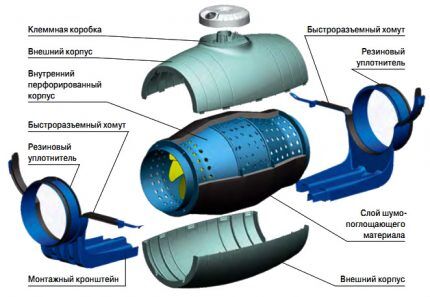
But you still need to remember that often the sound produced by these fans at 30-35 dB, even from a distance of several meters, will irritate users. This is especially true for situations where there is a bedroom or children's room next to a toilet or bathroom equipped with ventilation equipment.
As a result, you should know that truly silent, and without any compromises or marketing tricks, are considered models whose performance characteristics do not exceed 25 dB. In this case, the sound of the fan running is comparable to a very quiet whisper.
Since the good is always the enemy of the best, when purchasing you need to remember that models that fall into the category of market leaders in terms of noiselessness emit no more than 20-22 dB.
And although the advantage over conventional low-noise models may seem insignificant, it may well become decisive after several years of operation. Those. when the performance characteristics of the device decrease, the bearings begin to wear out, the air channels become clogged with dust, and the anti-noise gaskets wear out.
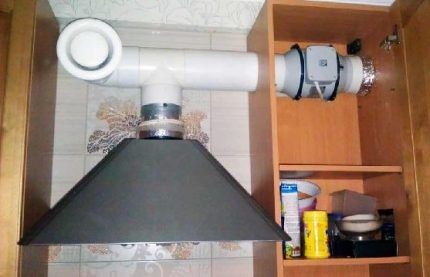
A number of complex solutions from engineers can provide a comfortable sound of operating ventilation equipment.
These include the following:
- use of high-precision bearings — such high-quality and balanced products eliminate beating, as a result of which there will be no vibration, which, when resonating, can significantly enhance the sound;
- high technology blades — one of the reasons for noise is the aerodynamic component, so developers, wanting to make the sound comfortable, carefully select the number of blades, optimal angles of inclination, and also carry out precise balancing of the impeller elements during manufacturing;
- use of technological buildings — high-quality manufacturing materials (metal, plastic) eliminate vibration of individual parts and assemblies, aerodynamic noise of moving air;
- using vibration damping pads — quiet operation is also achieved by using special types of rubber as gaskets to eliminate contact between the housing itself and the attachment points of the electric motor to it.
Gaskets have become an important design element; they insulate the fan housing from the air duct and wall.
Bearings, blades and special housings and gaskets - all this reduces vibration, turbulence of air flows and their resonance to insignificant values.
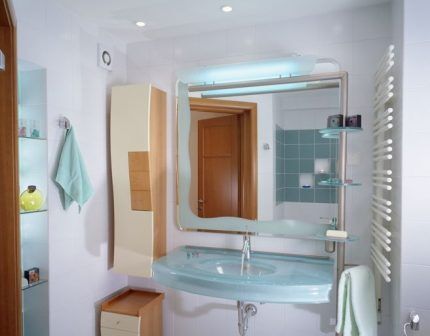
Today it is no longer uncommon to decorate ventilation shafts with modern soundproofing materials. Reduces noise and securely mounts the electric motor to the housing. The power plants themselves are common and are used on all types of fans.
Fan Performance Indicators
This characteristic is considered one of the most important, as it is interconnected with noise.It is clear that the higher the performance, the louder the electric motor and accompanying sounds sound.
As a result, it is thoughtless to buy exhaust fan for bathroom, to the kitchen, to the toilet according to the principle “you can’t spoil the porridge with butter”, as this can result in a decrease in the comfort of your stay and financial losses.
But it is not difficult to avoid negative consequences. That is, the optimal power can be calculated, knowing that such an indicator must correspond to the derivative of the volume of the room and the air exchange rate.
For example, the volume of a shower room is 5 m³, and the recommended air exchange rate, according to SNiP, is 7-9. And to calculate productivity, you just need to multiply cubic meters by any multiple number. The result will be 35-45 m³/hour.
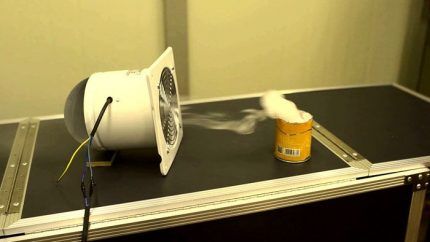
Different fan types perform a number of important options. Therefore, so that during operation you do not have problems with the device, you should pay attention to a number of characteristics when purchasing.
Which, in any situation, include:
- design safety;
- functionality;
- geometric dimensions;
- price.
Although all of the listed features are traditionally in the shadow of the main performance characteristics (performance, noise), they cannot be called secondary. Since each of them significantly affects the characteristics of ventilation equipment.
The importance of safe design
Since duct-type fans are designed for ventilation in all kinds of rooms, they often have to work in difficult conditions. Which create increased humidity in the bathroom, kitchen, toilet, the presence of fat particles in food preparation areas and increased dust in other rooms.
All of the above has a significant impact on the performance and durability of the unit. And most importantly, it affects the safety of living. Since particles of moisture and fat can always lead to a short circuit and other negative consequences.
Each used silent fan must be, at a minimum, splash-proof, and even better, moisture-resistant. An effective measure to take care of your health is to purchase a unit that operates on low voltage, which is considered to be 24 V, but its power will not be sufficient in all cases.
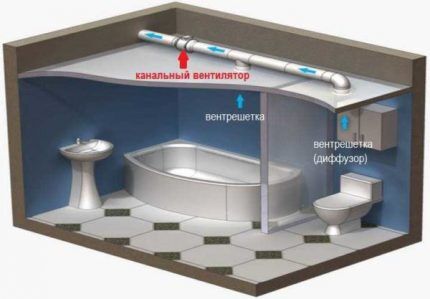
And the most practical solution would be to buy a fan with a protection class of at least IP34. Because as a result, the user will protect himself and his loved ones from all sorts of unpleasant incidents.
The importance of equipment functionality
Modern duct fans designed for hoods in the bathroom or in the kitchen, they are quite technologically advanced and the buyer has the right to choose a device with the most suitable operating mode, which can be:
- standard;
- auto;
- autonomous.
In the first case exhaust fan connected to the same electrical switch as the lighting of the room in which it is installed.As a result, both lamps and ventilation equipment are switched on simultaneously.
The shutdown procedure occurs in the reverse order, that is, after shutdown, the ventilation and lighting of the room stops.
The method described above is quite convenient and effective for use in combined bathroom, but is already considered obsolete. The reason is that short ventilation cycles are not able to successfully cope with high humidity, for example, in a bathroom.
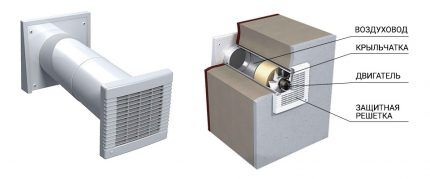
Some types exhaust devices can work autonomously, determining the level of pollution independently. Less technologically advanced fans operate based on programs embedded in their timers, and the simplest products are ventilated in the interval between switching on/off, which is carried out by the user.
This feature does not make it possible to effectively cope with the replacement of air masses with fresh ones or leads to excessive energy consumption, and an impressive one at that. The automatic ventilation option implies that the fan has a timer, which allows you to set the ventilation period taking into account the conditions in a particular room.
As a result, the procedure looks like this:
- The user, entering the bathroom or any other room with a fan, turns it on by pressing the switch button.
- The ventilation device removes contaminated air masses, even after a person leaves the room.
- Stopping occurs automatically after a user-specified period of time has elapsed.
The advantage of this type of equipment is the ability to select the optimal mode for all cases. At the same time, user participation in the work is minimal.
The most modern are duct fans capable of performing air exchange in autonomous mode. What the presence of sensors (for example, humidity) allows you to do. The signal from which leads to the fan itself being turned on/off.
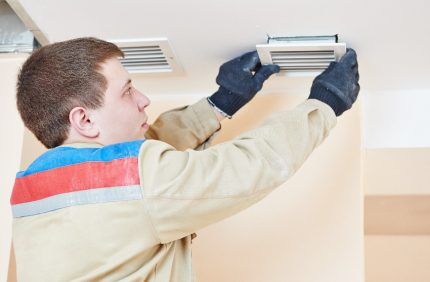
The advantage of the latter method is its greatest efficiency. That is, the air is always clean, and user participation is not required; it is also important that there is no excessive consumption of electricity.
Shape, size and cost
Today, fans with different housing shapes are available for sale.
Which are:
- round;
- rectangular;
- square.
But you should know that mainly products belonging to the first type are used for household purposes.
Rectangular and square analogs are most often classified as productive industrial devices, so the owner of a house, apartment, or office is unlikely to have to deal with them. The only exception will be cases when a vertical ventilation pipe is used in the form of a separate box.
The main geometric parameter of household duct fans is the mounting size. For example, this characteristic is always indicated on the body ventilation device and in its technical documentation, since it is quite capable of affecting performance.
In addition, the indicated dimensions are standard values, which makes it easier to select a fan.

Therefore, you should know that for household purposes, devices marked 100, 125 or 150 mm will be optimal. For ventilation in non-standardly large residential premises, restaurants, offices, options that indicate 160 mm or 200 mm are suitable. Large size products are classified as industrial.
Since the performance, functionality of fans, quality of materials and the amount of work required to ensure noiselessness are radically different, their prices are also significantly different.
As a result, you will have to pay a very reasonable amount for an inexpensive option. But for a model capable of operating autonomously, that is, equipped with a humidity sensor, a controller and capable of operating reliably silently for many years, you need to pay many times more.
For comparison: for that kind of money you can buy a pretty decent smartphone. However, the most affordable fans are not the best option. After all, they are not designed for a high level of safety or durability.
Types of duct fans
Today at points of sale you can find fans of several different types.
These include:
- axial, less often called axial;
- radial;
- centrifugal.
Each type has its own advantages and disadvantages, so you should know them.
Group #1 - axial fans
A characteristic feature of this variety is the direction of air flows along the axis of the electric motor, on which the impeller is located, which is responsible for the movement of air masses.
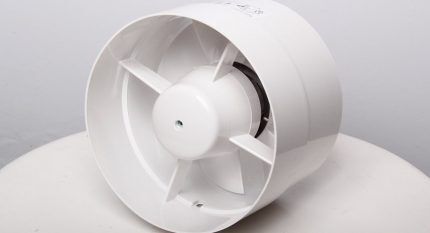
The main advantages of axial fans for all kinds of hoods are:
- low productivity required to move air masses;
- economical electric motor;
- simple design.
The listed features make units belonging to the presented type the most silent without any additional measures. This allows us to rank them among the most affordable, and therefore in demand for any household needs.
The main disadvantage is considered to be low performance, which is still quite sufficient for solving various local problems.
Group #2 - radial fans
Such devices are more technologically advanced than the axial ones described above. This is evidenced by the fact that the air flows do not move directly along the axis, but thanks to the special shapes of the impeller blades, they are mixed, compressed and directed towards the housing.
In this case, a vacuum effect is created behind the trailing edges. This leads to rapid absorption of external air currents.
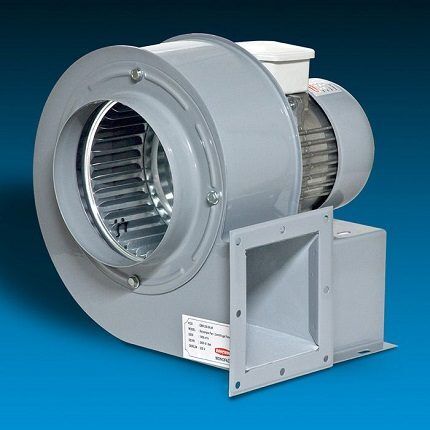
Thus, the radial type of fan intended for exhaust comes in two types:
- with shoulder blades tilted forward;
- with shoulder blades tilted back.
The first type is optimal for silent operation; moreover, it is more economical, by an impressive 20%. But if performance is an important parameter, then it is better to purchase fans whose blades are tilted back.
An important feature of each radial fan for any type of hood is compactness. This advantage is especially valuable when the installation space is difficult to access or limited.
Group #3 - centrifugal fans
This is the most modern, quietest and most efficient type of duct fans. Their operating principle is similar to their radial counterparts. That is, closer to the body, increased pressure is created, and in the center there is a rarefied space, which leads to more efficient suction of external air masses.
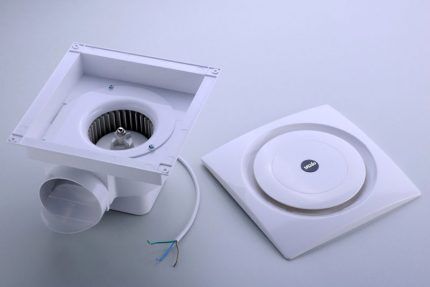
Features of the design and operating principle makes centrifugal fans the quietest. In addition, they can be installed directly in the ventilation shaft of the apartment, which eliminates the negative impact on the aesthetic properties of the room.
And most importantly, this helps to increase the power of units of this type and reduce the impact of moisture and dust on them, which extends their service life.
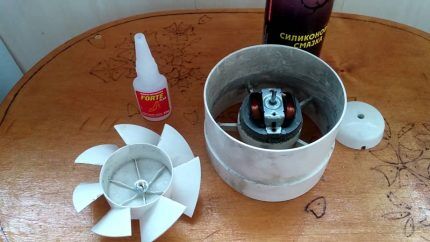
A significant disadvantage of any centrifugal fan is its high performance, as a result of which they can only be used in rooms of 15 m² or more.
Conclusions and useful video on the topic
This video provides an opportunity to familiarize yourself with what a duct fan is and understand the principle of its operation:
Among modern duct fans, it is quite possible to find a silent model of the required power, characterized by durability and safety, and in various price categories. But at the same time, you must have a certain amount of knowledge or you will not be able to get the expected result..
Would you like to tell us about how you chose a silent fan for installation in the exhaust duct? Share what was the main selection criterion for you personally. Please leave comments in the block below, ask questions and post questions on the topic of the article in the block below.




We purchased a house that has a large basement with brick walls, very well finished, but there is no ventilation in it and this causes drops of condensation to appear on the ceiling in the hot season. I liked how the different types of fans are described. I would like to ask which one is suitable for the basement and in what place is it best to install it?
First of all, you need to calculate the minimum cross-section of the ventilation duct for the cellar, based on the total area of the basement. In accordance with this, select a fan of the required power. I cannot recommend you any specific model of duct fan, since I do not have any input data.
I am attaching a simple air exchange diagram in the cellar that you can use as a guide. And as a bonus, a photo of the air duct outlet implemented in my basement. You decide for yourself where it is more convenient and practical to install ventilation, based on the layout.
Hello, tell me, I need to install a fan in the bathroom on a suspended PVC ceiling - which fan is suitable for this? Maybe there are special ceiling models?
Everything would be fine, but the article does not touch on pressure characteristics at all, for example, an axial fan gives low pressure and performance drops significantly depending on the length of the air ducts and filters, if any.